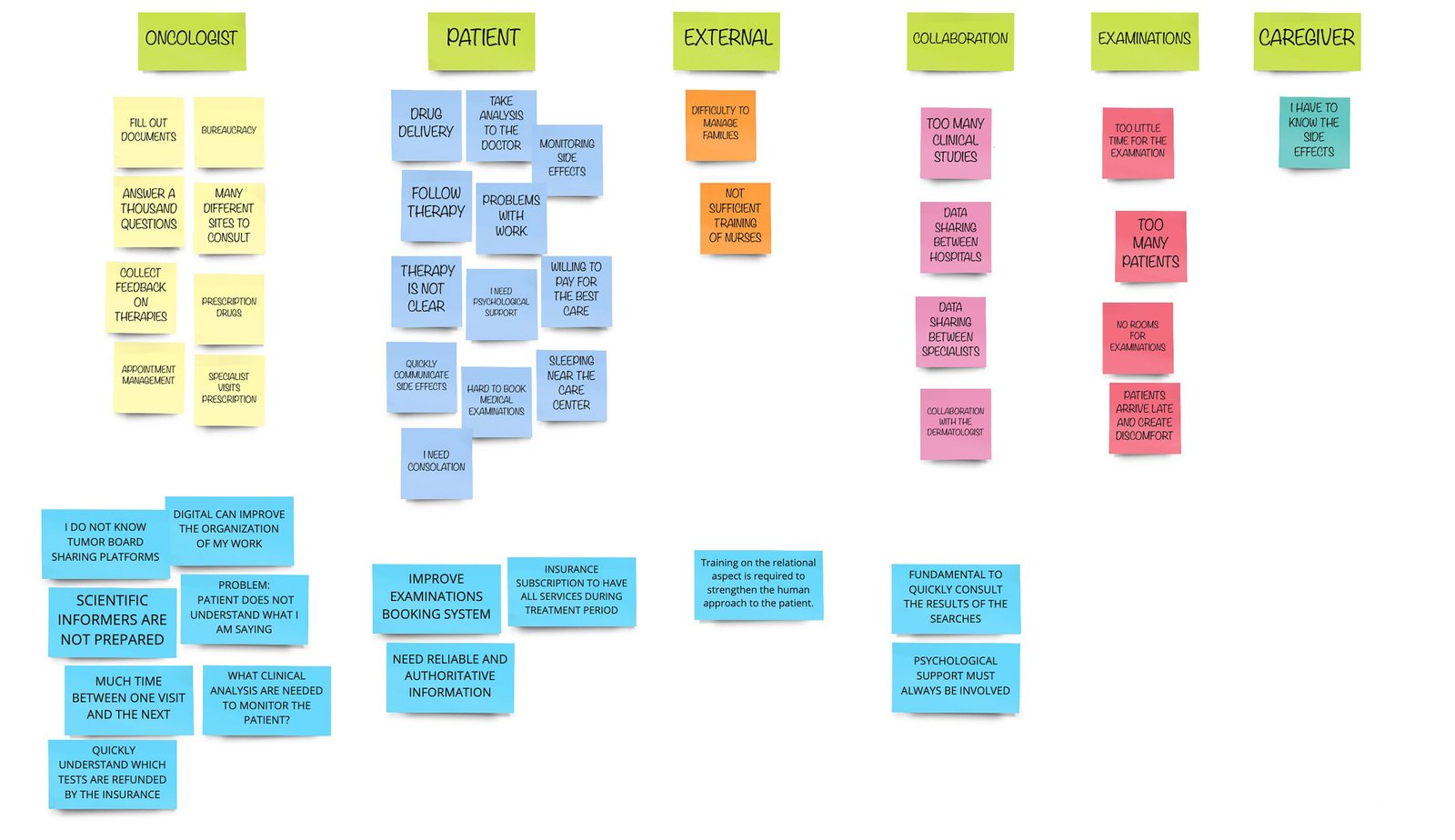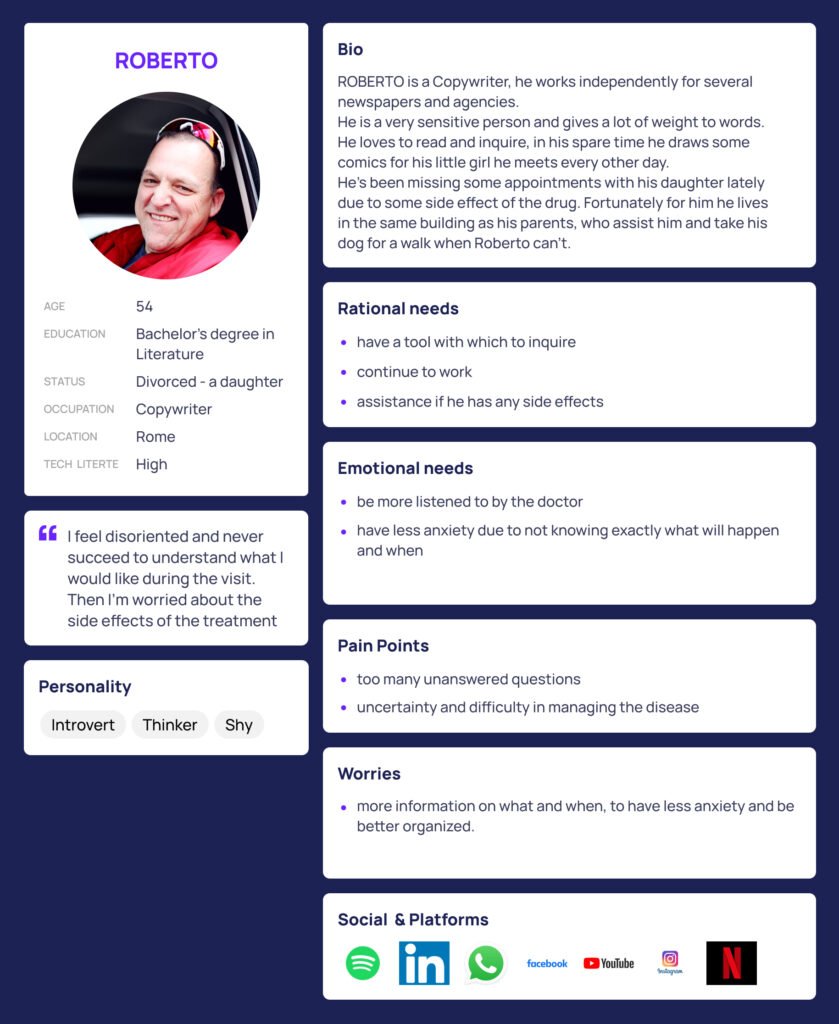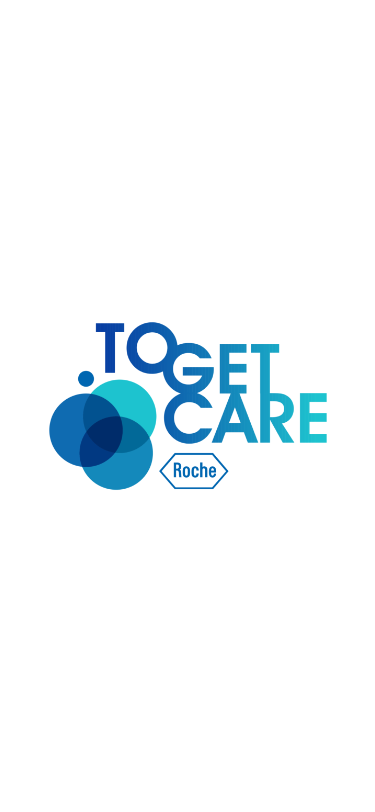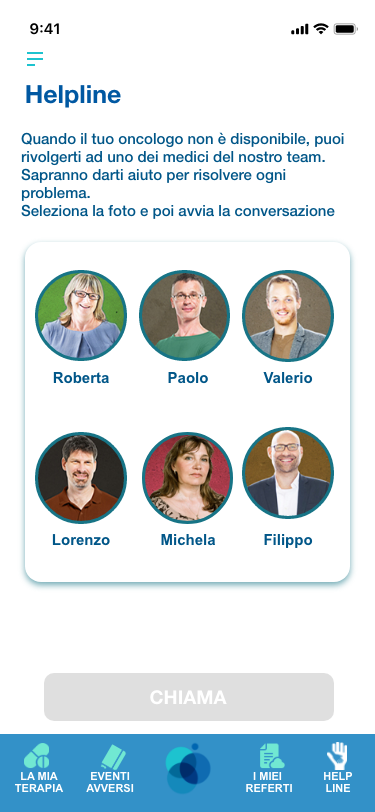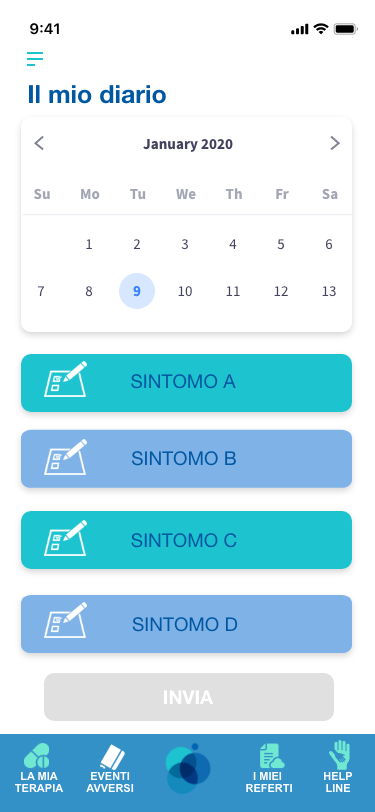ROLE
RESEARCHER
PRODUCT DESIGNER
PROTOTYPER
TEAM
Claudio Neri
Chiara Montanaro
Lavinia Palma
Alessandro Di Maio
Dalila Parisi
DURATION
6 weekends
OVERVIEW
CUSTOMER BRIEF
“Roche is a leading pharmaceutical and melanoma company. But that’s not enough. We need better outcomes for more patients, faster.
Treating melanoma is not made up of drugs alone, it is made up of expectations, communication, empathy and human relationships.”

NO PREVENTION
LATE DIAGNOSIS

TOO MUCH TIME TO ACCESS THERAPIES
REGIONAL DIFFERENCES IN TREATMENTS

PATIENTS ARE FORCED TO TRAVEL

The Challenge
-
Detect major pain points in melanoma treatments for patients and oncologists
-
Change the patient and doctor journey to achieve better experience, fastest access to treatments, better results
-
Develop a new Business Model to shift the actual toward a complete system of Healthcare Provider where value is created by the integration of goods and services as well as drugs
-
Prototype a solution that creates value for oncologists and patients
WHAT WE DID
UNDERSTAND ->RESEARCH -> SYNTHESIZE -> CREATE
Understand->
Having a completely different background, the initial challenge was to understand and analyze in which domain we were moving.
We needed to know:
- Who is Roche? What is its history, what are its goals
- What is melanoma? What does it look like, how is it treated?
- What Do Oncologists Do? Who do they work with?
- Who are the patients? Who they turn to, how they face the disease
Research->
In order to intercept all the needs of patients and oncologists, to bring to light the critical issues and to identify all the areas where improvement could have been possible, we used surveys.
Starting from the results of the surveys, we then conducted interviews.
These user interviews allowed us to validate what emerged from the quantitative research but also to discover the deep reasons for dissatisfaction, pain points but also the wishes of doctors and patients.
Our research by numbers
Patients survey
132
Patients interviews
2
Oncologists surveys
56
Oncologists interviews
9
The first step was to collect and analyze the survey results. During this analysis we clearly saw clusters emerge from the responses.
As a remote workgroup we had the opportunity not to waste tons of post-its using an online board. This allowed us to observe and organize the responses both in collaborative sessions but also to reflect in separate moments in order to think independently and without influencing each other.
After the surveys we had the opportunity to interview some of the people to investigate the motivations behind their answers.
Talking directly with them allowed us to go deeper, to bring out even more elements, personal and professional, to better define the problems. To highlight all the moments of difficulty, the pain points, and everything that could be improved.
Synthesize->
The following step was to synthesize, map, represent in a clear and simple way, to always keep in front of the eyes to answer the question “how might we?”
This synthesis activity led us to represent our actors, our personas, who are the protagonists of our experience map.
Our personas, in addition to providing a real representation of our users, have allowed us to get even more in touch with a world unknown to us and which needs deep understanding, both for professionals and for patients.
And now, how do they move within the overall experience?
We knew we needed to improve the oncologists’ experience, but to understand exactly how, it was necessary to clearly observe the interactions between the two users. How the frustrations of the first interact on the second, what does one need to make the other’s work more effective?
Our map clearly shows their path and interactions by highlighting the overlap of pain points.
The last step of the synthesis activity is the one that guided us to turn problems into opportunities: the magic moment of the How Might We questions.
We have found that the greatest difficulties come from:
- Lack of time
- Much bureaucracy
- Fear of the disease
- sense of abandonment
- need for constant updates
Create->
HOW MIGHT WE…

One of the main causes of waste of time for the doctor, especially in the first visit, consists in the compilation of various documents, intended for different subjects and which often require the same data and which must subsequently be sent on different platforms.
Our proposal is to provide a barcode scanner that allows you to read all patient data through the electronic health card and automatically fill in all common data of the documentation to be sent.
The doctor will only have to worry about entering the specific data of each document
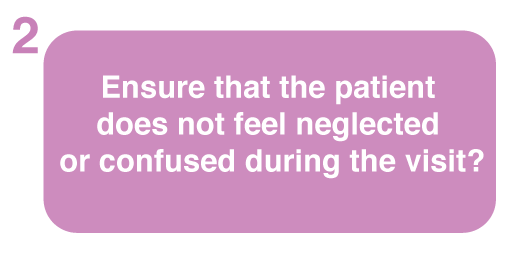
During the first visit the patient feels confused because the main interest of the doctor is to collect the data seen in the previous point to start all the bureaucratic procedures. Although essential, this gives the patient the image of a doctor who is not very interested in the clinical case to be treated.
The patient would like to ask a thousand questions but there is no time, often the terminology used by the oncologist is unclear, any relatives make the visit even more complicated.
Our solution involves the creation of an app called Togetcare in which the patient can find a series of specific information on the first visit and on the terms used by doctors. In this way the patient will know exactly how the visit will be conducted and also the meaning of some apparently strange words in the section called wikinoma.
Onboarding can take place directly in the oncologist’s office through advertising material or even before, at the time of booking the visit, the telephone attendant can invite the patient to download the app

Frequently, when the side effects of therapy occur, the patient is alone and cannot assess the actual severity of the same. His oncologist almost certainly has no way to support him/her and adequately explain what is happening. But in those moments having a reference figure is also essential to give correct psychological support.
On the other hand, the oncologist is not always up to date on the onset of side effects, effects which will then be reported with delay during the next visit, causing further waste of time. Togetcare offers the solution: when side effects occur, the patient will have a 24-hour support helpline managed by professional doctors. Furthermore, the patient, through the app, will be able to record all adverse events, whenever they occur, to keep his oncologist informed, who will read everything on the patient card in his application.
Similarly, the patient can record the results of the medical tests requested by their doctor

What happens when the patient is forced to go to the emergency room to manage serious side effects? He/she should bring his/her medical record to show to the emergency room triage to better explain the medical situation and allow doctors to take appropriate action.
What if the patient has no way to bring his documentation?
Togetcare offers the possibility to save all relevant clinical news on the app, the patient just needs to show a QR Code on the app with a link to all medical data.
What if the patient is not conscious?
The application can manage one or more caregivers who have the ability to show the same code to access the data. Hospitals using the platform have the ability to record which treatments have been performed and to inform the patient’s oncologist at the same time.
Togetcare provides for the management of premium services, among these we have designed an elegant NFC bracelet that can be easily scanned by emergency room doctors and that allows access to the same data. Other premium services include: specialist visits at favorable prices, caregiving service, home drug delivery.
All premium services can be offered in partnership with the main players in each sector
IF YOU’RE INTERESTED
app prototype (in italian at the moment)
desktop prototype (in italian at the moment)

